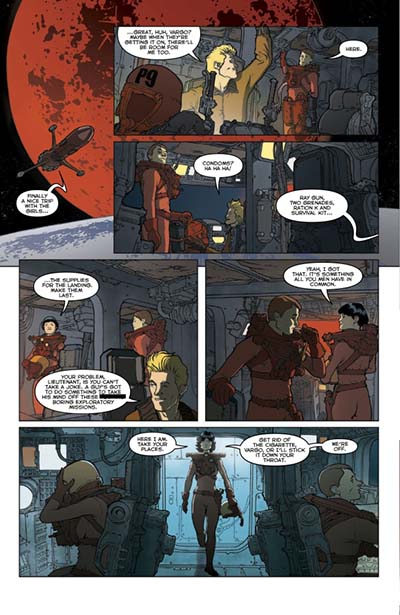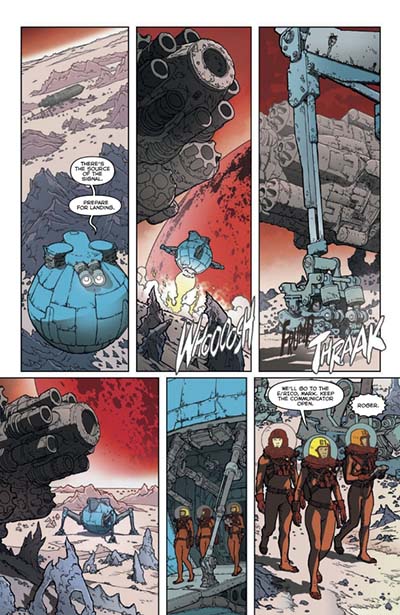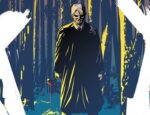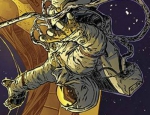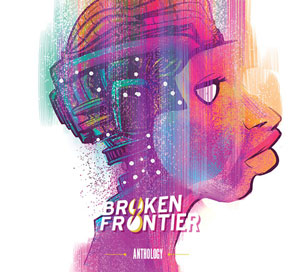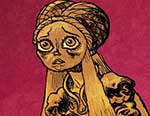The Shadow Planet, according to the blurb on the back of the book, is “a story of Lovecraftian horror in space”. That isn’t a very accurate description, though. Lovecraft is famous for his slow and claustrophobic style, relying heavily on hints and suggestions, gradually building up layers of atmosphere and tension, and giving us comparatively little in the way of action or dialogue. The Shadow Planet, on the other hand, is a gore-drenched sci-fi horror-romp with lots of visceral thrills and jump-shocks, gratuitous sex, people being dismembered, humans morphing into alien monsters, aliens morphing into humans, eyeballs coming out, bowels exploding, bad-ass swearing, big fights, big explosions, etc. The ‘Bonus Material’ section at the end of the book says it was “conceived as the comic book version of a B-Movie never made”, and that’s a much better description.
It owes a big thematic and stylistic debt to Alien. A retro, rust-bucket-style spaceship, with a quarrelsome male-and-female crew, receives a distress call from a planet they happen to be passing, and they send down a shuttle craft to investigate. On the planet, the shuttle crew find a wrecked spacecraft, which is the source of the distress call. All but one of its crew have been killed/absorbed by a predatory alien which lives in an ancient city below the surface of the planet.
The alien wants to find a way off the planet in order to access more victims, and the shuttle crew soon find themselves in a struggle for survival. To complicate matters, rather than killing its victims outright, the alien absorbs them, which gives it the power to assume their identities for the purposes of camouflage. So we’re soon in a situation where it’s very difficult to tell who can be trusted and who might be the alien in disguise.
Both the retro-futuristic design of the spaceship, and the organic-monumental look of the underground city, are very reminiscent of Alien. The artwork is superb throughout. Perspective, lighting, the surface of the planet, the different space-ships, the subterranean caverns full of enormous mushrooms and mutant insects, are all rendered in convincing detail. There’s a blue three-wheeled car, used for driving around on the surface of the planet, which is a particularly nice piece of design: it looks as if it might have come straight off the streets of 1960s Turin.
One weakness is that when everyone is wearing a space suit, it can sometimes get difficult to tell which character is which. Another is that the story is full of gratuitous elements. There’s quite a bit of gratuitous sex, but there’s also a gratuitous robot (superbly drawn, of course), which doesn’t actually serve any useful purpose in the plot. The underground city, home of the alien, is also inhabited by troll-like hominids and some spooky characters in hooded cloaks, who don’t seem to have anything much to do with the plot either.
There are also some gratuitous dream sequences. One of the shuttle crew dreams that he’s taking part in a ritual in the underground city, surrounded by a crowd of the troll-like hominids and the spooky characters in cloaks. He’s wearing nothing but a loin cloth, and there’s a lot of chanting going on. He drinks some kind of potion which gives him an erection, and then he has a sexual liaison with one of the troll-like hominids. None of which has anything to do with the plot.
One stylistic device worth mentioning is the use of big (and often rather bizarre) sound-effects, spelt out across the frames in slanty letters:
“Let’s kick that monster’s ass”… WHRRR WHRRRRRR… “Oh, shit”… ZAP ZAP ZAP… FLARG BWOSH… CHUNK ZAP ZAP… BLORT… “Fuck you!”… KDIK… WHUMP… BHUKWAAM FLORT SPLAT… “Die, you bastard!”… ZAP ZAP… ZAP ZAP BLATCH WHAK… “What the…” … KUHWOOOOOOM
I mean, what’s not to like about that?
This is a comic-book B-movie. Thematic depth and rigorous construction aren’t to be expected: the object of the exercise is to deliver thrills and visual treats within the framework of an already familiar plot, and in this respect The Shadow Planet absolutely does its job. It’s only 82 pages long, and it’s thoroughly entertaining from start to finish.
Gianluca Paliarani & Gionvanni Barbieri (W), Gianluca Paliarani (A), Alan D’Amico (C) • Image Comics, $12.99
Review by Edward Picot







